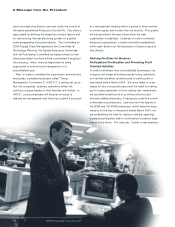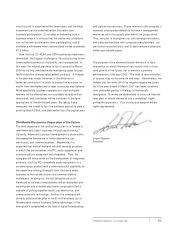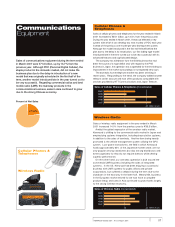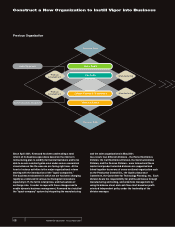Kenwood 2001 Annual Report Download - page 7
Download and view the complete annual report
Please find page 7 of the 2001 Kenwood annual report below. You can navigate through the pages in the report by either clicking on the pages listed below, or by using the keyword search tool below to find specific information within the annual report.
KENWOOD Corporation Annual Report 2001
05
Hiroshi Nakano
President
only if a profit is expected within three years and the initial
investment can be collected within five years (new
business participation), 2) consider withdrawing from a
business when it is obvious that the above two conditions
can not be met (continuation after participation), and 3)
consider a withdrawal when accumulated losses exceeded
1.0 billion.
Now that the CD-ROM and GSM businesses have been
terminated, the biggest challenge is the restructuring of the
home audio business so that profits can be expected. In
this area, the original plan was to turn it around by March
2004 by cutting overhead while maintaining sales through
the introduction of more value-added products. A change
in the plan was made, however, in the direction of
"balanced contraction" in order to assure the outcome no
matter how the market and foreign currencies may behave.
More specifically, business operations in non-profitable
markets will be diminished, non-profitable models will be
terminated, and overheads will be cut down to the level
appropriate to the diminished sales. By taking these
measures, we intend to turn the business around to yield a
profit by March 2003, one year earlier than the original plan.
The Mobile-Electronics Corporation of the Future
The third objective in the restructuring plan is to "create a
new Kenwood style in business through restructuring."
Currently, Kenwood's product development is done within
the respective framework of home electronics, car
electronics, and communications. Meanwhile, it is
expected that market demand will shift towards products
in which the functionalities of a PC, audio equipment and
communications equipment are integrated. Thus, the
company will focus more on the development of integrated
products, such as PC-compatible audio equipment or a
car electronics product with a communication capability, at
the same time shifting its weight from the home audio
business to the car electronics and communications
businesses. In doing so, the old characterization of
Kenwood as an audio manufacturer will be discarded and
we will grow into a mobile-electronics corporation that is
capable of putting together audio, car electronics, and
communications technology. Further, the company will
strive to build another pillar in the B-to-B business out of
the electronic device business, taking advantage of the
stronghold it established in the field of digital broadcasting
and optical microphones. These reforms in the company's
business structure are difficult to achieve if management
resources are to be sought after within the group alone.
Thus, we plan to strengthen our joint development efforts
and sales partnerships with computer manufacturers, car
electronics manufacturers, and hi-tech venture businesses
inside and outside Japan.
The purpose of the aforementioned reforms is to lay a
foundation on which Kenwood can sustain mid- to long-
term growth in the future, not to mention a positive
performance in the year 2002. The road to reconstruction,
of course, may not be smooth and easy. Nevertheless, we
believe that the write-off of the negative legacy we opted
for in the year ended in March 2001 has freed ourselves
from obstacles getting in the way of Kenwood's
resurgence. Now we are determined to carry out the mid-
term plan to reform Kenwood into a revitalized, highly
profitable corporation. Your continuous support will be
highly appreciated.




















